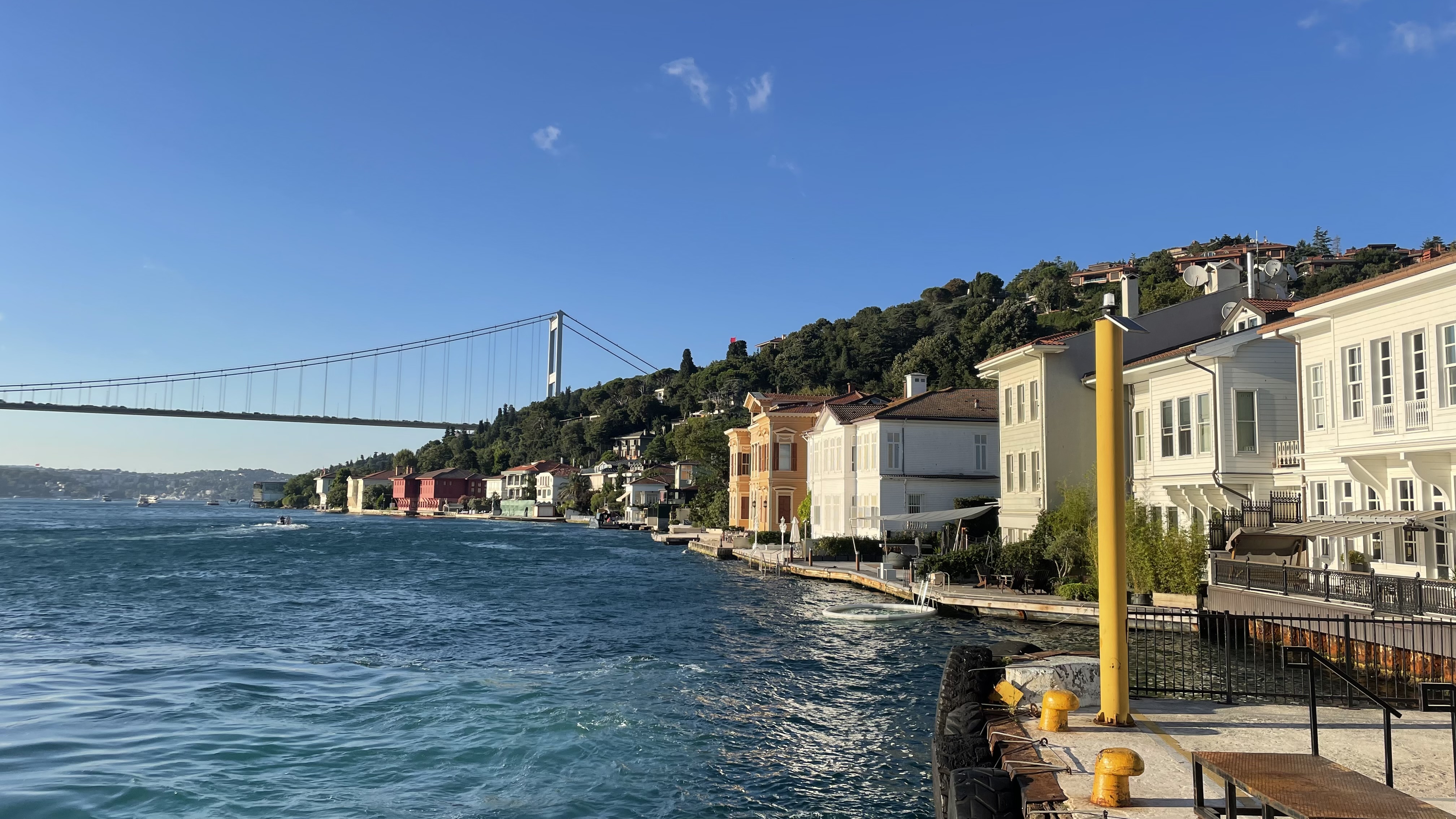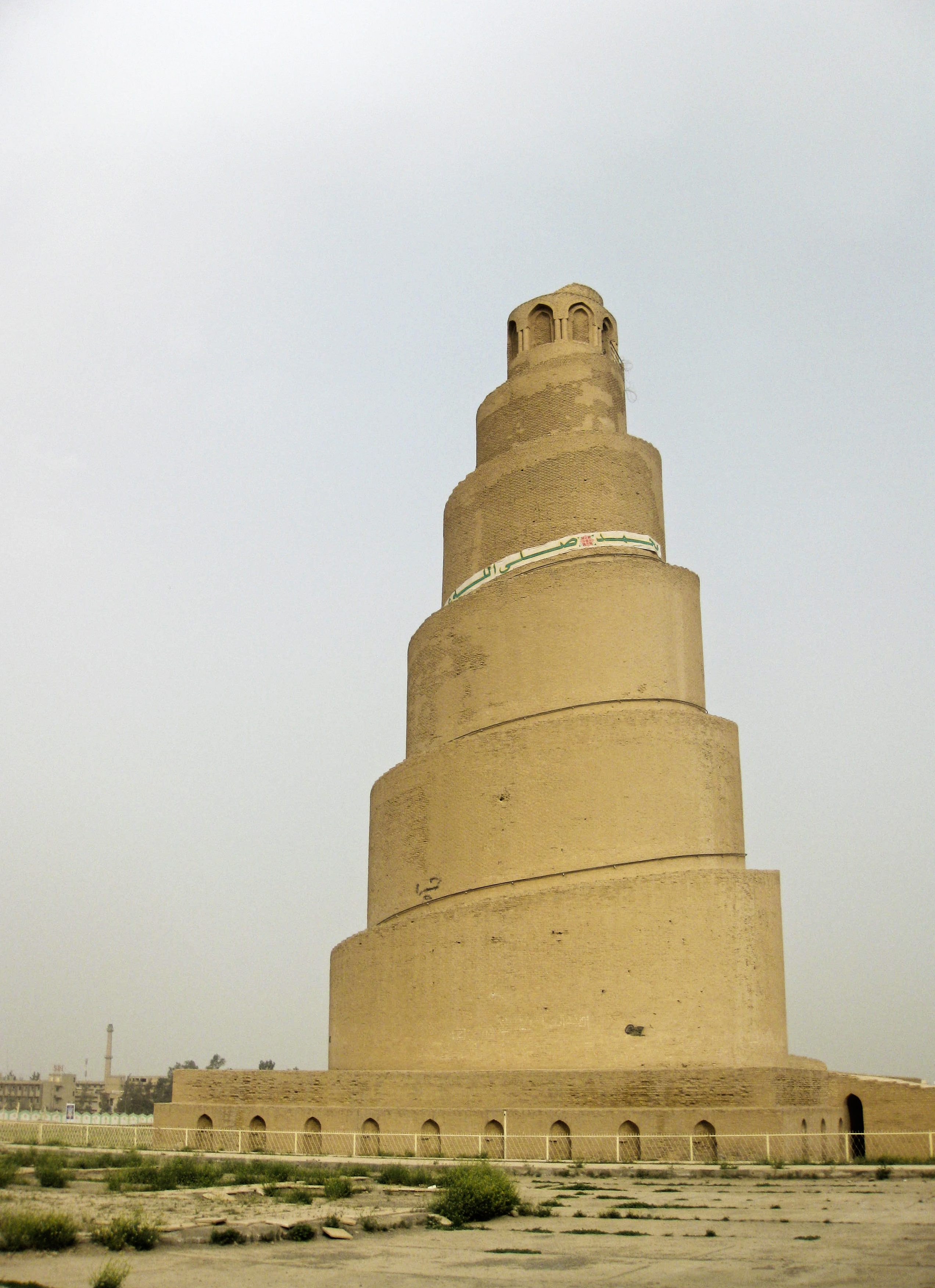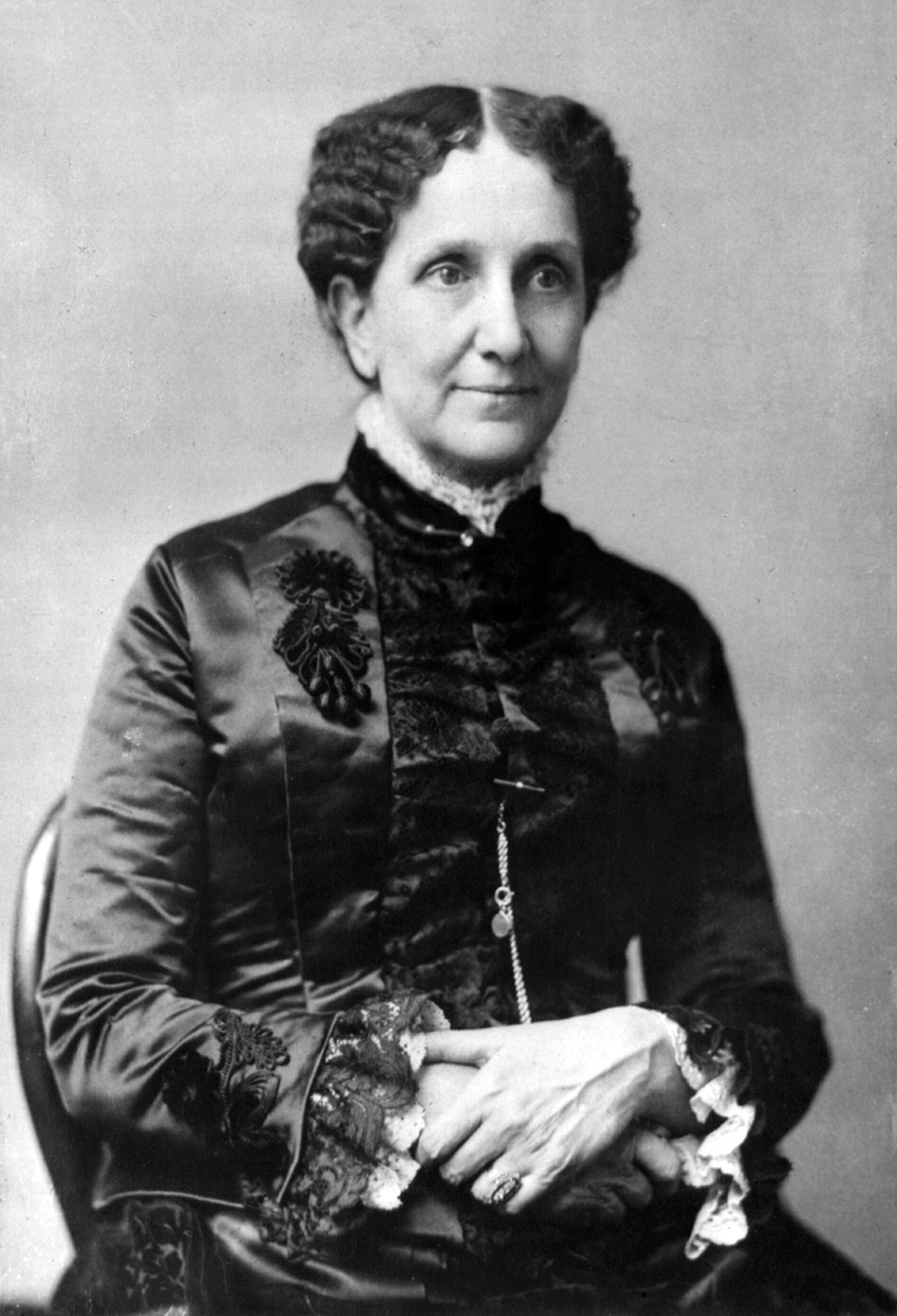|
┼×akirin Mosque
┼×akirin Mosque (pronounced Shakirin) is a mosque in Istanbul, Turkey. The building is located at one of the entrances of the historic Karacaahmet Cemetery in ├£sk├╝dar. It was built by the Semiha ┼×akir Foundation in memory of ─░brahim ┼×akir and Semiha ┼×akir and opened on 7 May 2009. According to newspaper reports, it is the most carbon-neutral mosque in Turkey. History The mosque's architect was H├╝srev Tayla, known for his work on Kocatepe Mosque in Ankara and for his architectural conservation work. Its interior designer was Zeynep Fad─▒ll─▒o─¤lu, a great-niece of Semiha ┼×akir, and also according to newspaper reports, the first female interior designer of a mosque, as well as the first woman to design a mosque in modern Turkey. Construction of the mosque took four years. It is 10,000 square meters in area. It has two minarets, each 35 meters high, and a dome of aluminum composite. The calligraphy on the interior of the dome was written by Semih ─░rte┼¤. The large windows ... [...More Info...] [...Related Items...] OR: [Wikipedia] [Google] [Baidu] [Amazon] |
Üsküdar
├£sk├╝dar () is a municipality and district of Istanbul Province, Turkey. Its area is 35 km2, and its population is 524,452 (2022). It is a large and densely populated district on the Anatolian (Asian) shore of the Bosphorus. It is bordered to the north by Beykoz, to the east by ├£mraniye, to the southeast by Ata┼¤ehir and to the south by Kad─▒k├Čy; with Karak├Čy, Kabata┼¤, Be┼¤ikta┼¤, and the historic Sarayburnu quarter of Fatih facing it on the opposite shore to the west. ├£sk├╝dar has been a conservative cultural center of the Anatolian side of Istanbul since Ottoman times with its landmark as well as numerous tiny mosques and dergahs. ├£sk├╝dar is a major transport hub, with ferries to Emin├Čn├╝, Karak├Čy, Kabata┼¤, Be┼¤ikta┼¤ and some of the Bosphorus suburbs. ├£sk├╝dar is a stop on the Marmaray rail service at the point where it starts its journey under the Bosphorus, re-emerging on the European side at Sirkeci. Via Marmaray, ├£sk├╝dar is linked to Gebz ... [...More Info...] [...Related Items...] OR: [Wikipedia] [Google] [Baidu] [Amazon] |
Islam
Islam is an Abrahamic religions, Abrahamic monotheistic religion based on the Quran, and the teachings of Muhammad. Adherents of Islam are called Muslims, who are estimated to number Islam by country, 2 billion worldwide and are the world's Major religious groups, second-largest religious population after Christians. Muslims believe that Islam is the complete and universal version of a Fitra, primordial faith that was revealed many times through earlier Prophets and messengers in Islam, prophets and messengers, including Adam in Islam, Adam, Noah in Islam, Noah, Abraham in Islam, Abraham, Moses in Islam, Moses, and Jesus in Islam, Jesus. Muslims consider the Quran to be the verbatim word of God in Islam, God and the unaltered, final revelation. Alongside the Quran, Muslims also believe in previous Islamic holy books, revelations, such as the Torah in Islam, Tawrat (the Torah), the Zabur (Psalms), and the Gospel in Islam, Injil (Gospel). They believe that Muhammad in Islam ... [...More Info...] [...Related Items...] OR: [Wikipedia] [Google] [Baidu] [Amazon] |
21st-century Mosques In Turkey
File:1st century collage.png, From top left, clockwise: Jesus is crucified by Roman authorities in Judaea (17th century painting). Four different men (Galba, Otho, Vitellius, and Vespasian) claim the title of Emperor within the span of a year; The Great Fire of Rome (18th-century painting) sees the destruction of two-thirds of the city, precipitating the empire's first persecution against Christians, who are blamed for the disaster; The Roman Colosseum is built and holds its inaugural games; Roman forces besiege Jerusalem during the First JewishŌĆōRoman War (19th-century painting); The TrŲ░ng sisters lead a rebellion against the Chinese Han dynasty (anachronistic depiction); Boudica, queen of the British Iceni leads a rebellion against Rome (19th-century statue); Knife-shaped coin of the Xin dynasty., 335px rect 30 30 737 1077 Crucifixion of Jesus rect 767 30 1815 1077 Year of the Four Emperors rect 1846 30 3223 1077 Great Fire of Rome rect 30 1108 1106 2155 Boudican revolt ... [...More Info...] [...Related Items...] OR: [Wikipedia] [Google] [Baidu] [Amazon] |
Mosques Completed In 2009
A mosque ( ), also called a masjid ( ), is a place of worship for Muslims. The term usually refers to a covered building, but can be any place where Islamic prayers are performed; such as an outdoor courtyard. Originally, mosques were simple places of prayer for the early Muslims, and may have been open spaces rather than elaborate buildings. In the first stage of Islamic architecture (650ŌĆō750 CE), early mosques comprised open and closed covered spaces enclosed by walls, often with minarets, from which the Islamic call to prayer was issued on a daily basis. It is typical of mosque buildings to have a special ornamental niche (a ''mihrab'') set into the wall in the direction of the city of Mecca (the ''qibla''), which Muslims must face during prayer, as well as a facility for ritual cleansing (''wudu''). The pulpit (''minbar''), from which public sermons (''khutbah'') are delivered on the event of Friday prayer, was, in earlier times, characteristic of the central city mosque, ... [...More Info...] [...Related Items...] OR: [Wikipedia] [Google] [Baidu] [Amazon] |
├ćaml─▒ca Mosque
The Grand ├ćaml─▒ca Mosque (, transliterated as Chamlija in English) () is a landmark complex for Islamic worship which was completed and opened on 7 March 2019. The mosque stands astride ├ćaml─▒ca Hill in the ├£sk├╝dar district of Istanbul and is visible from much of the centre of the city. The complex incorporates an art gallery, library, and conference hall. It can hold up to 63,000 worshippers at a time (can accommodate up to 100,000 people in case of an earthquake). The cost of the mosque was US$110 million (approx. 550 million Turkish liras at the time). Planning for the ├ćaml─▒ca Mosque began in the year 2000 and was led by two female architects, Bahar M─▒zrak and Hayriye G├╝l Totu. Their design won second prize in a competition to come up with something suitable. The mosque was officially inaugurated on 3 May 2019 by the current President of Turkey, Recep Tayyip Erdo─¤an. Several international leaders were present at the ceremony including Senegalese President Macky Sal ... [...More Info...] [...Related Items...] OR: [Wikipedia] [Google] [Baidu] [Amazon] |
Chandelier
A chandelier () is an ornamental lighting device, typically with spreading branched supports for multiple lights, designed to be hung from the ceiling. Chandeliers are often ornate, and they were originally designed to hold candles, but now incandescent light bulbs are commonly used, as well as fluorescent lamps and light-emitting diode, LEDs. A wide variety of materials ranging from wood and earthenware to silver and gold can be used to make chandeliers. Brass is one of the most popular with Dutch or Flemish brass chandeliers being the best-known, but glass is the material most commonly associated with chandeliers. True glass chandeliers were first developed in Italy, England, France, and Bohemia in the 18th century. Classic glass and crystal chandeliers have arrays of hanging "crystal" Prism (optics), prisms to illuminate a room with Refraction, refracted light. Contemporary chandeliers may assume a more minimalist design, and they may illuminate a room with direct light from t ... [...More Info...] [...Related Items...] OR: [Wikipedia] [Google] [Baidu] [Amazon] |
Sultanate Of R├╗m
The Sultanate of Rum was a culturally Turco-Persian Sunni Muslim state, established over conquered Byzantine territories and peoples (Rum) of Anatolia by the Seljuk Turks following their entry into Anatolia after the Battle of Manzikert in 1071. The name ''Rum'' was a synonym for the medieval Eastern Roman Empire and its peoples, as it remains in modern Turkish. The name is derived from the Aramaic () and Parthian () names for ancient Rome, via the Greek () meaning the Anatolia. The Sultanate of Rum seceded from the Seljuk Empire under Suleiman ibn Qutalmish in 1077. It had its capital first at Nicaea and then at Iconium. It reached the height of its power during the late 12th and early 13th century, when it succeeded in taking key Byzantine ports on the Mediterranean and Black Sea coasts. In the east, the sultanate reached Lake Van. Trade through Anatolia from Iran and Central Asia was developed by a system of caravanserai. Especially strong trade ties with the Genoese forme ... [...More Info...] [...Related Items...] OR: [Wikipedia] [Google] [Baidu] [Amazon] |
Minbar
A minbar (; sometimes romanized as ''mimber'') is a pulpit in a mosque where the imam (leader of prayers) stands to deliver sermons (, ''khutbah''). It is also used in other similar contexts, such as in a Hussainiya where the speaker sits and lectures the congregation. Etymology The word is a derivative of the Arabic root ''n-b-r'' ("to raise, elevate"); the Arabic plural is ''man─übir'' (). Function and form The minbar is symbolically the seat of the imam who leads prayers in the mosque and delivers sermons. In the early years of Islam, this seat was reserved for the Islamic prophet Muhammad and later for the caliphs who followed him, each of whom was officially the imam of the whole Muslim community. It eventually became standard for all Friday mosques and was used by the local imam, but it retained its significance as a symbol of authority. While minbars are roughly similar to church pulpits, they have a function and position more similar to that of a church lectern ... [...More Info...] [...Related Items...] OR: [Wikipedia] [Google] [Baidu] [Amazon] |
Calligraphy
Calligraphy () is a visual art related to writing. It is the design and execution of lettering with a pen, ink brush, or other writing instruments. Contemporary calligraphic practice can be defined as "the art of giving form to signs in an expressive, harmonious, and skillful manner". In East Asia and the Islamic world, where written forms allow for greater flexibility, calligraphy is regarded as a significant art form, and the form it takes may be affected by the meaning of the text or the individual words. Modern Western calligraphy ranges from functional inscriptions and designs to fine-art pieces where the legibility of letters varies. Classical calligraphy differs from type design and non-classical hand-lettering, though a calligrapher may practice both. CD-ROM Western calligraphy continues to flourish in the forms of wedding invitations and event invitations, font design and typography, original hand-lettered logo design, religious art, announcements, graphic des ... [...More Info...] [...Related Items...] OR: [Wikipedia] [Google] [Baidu] [Amazon] |
Minaret
A minaret is a type of tower typically built into or adjacent to mosques. Minarets are generally used to project the Muslim call to prayer (''adhan'') from a muezzin, but they also served as landmarks and symbols of Islam's presence. They can have a variety of forms, from thick, squat towers to soaring, pencil-thin spires. Etymology Two Arabic words are used to denote the minaret tower: ''man─üra'' and ''man─ür''. The English word "minaret" originates from the former, via the Turkish language, Turkish version (). The Arabic word ''man─üra'' (plural: ''man─ür─üt'') originally meant a "lamp stand", a cognate of Hebrew language, Hebrew ''Temple menorah, menorah''. It is assumed to be a derivation of an older Linguistic reconstruction, reconstructed form, ''manwara''. The other word, ''man─ür'' (plural: ''man─ü'ir'' or ''man─üyir''), means "a place of light". Both words derive from the Arabic root ''n-w-r'', which has a meaning related to "light". Both words also had other meani ... [...More Info...] [...Related Items...] OR: [Wikipedia] [Google] [Baidu] [Amazon] |
The Christian Science Monitor
''The Christian Science Monitor'' (''CSM''), commonly known as ''The Monitor'', is a nonprofit news organization that publishes daily articles both in Electronic publishing, electronic format and a weekly print edition. It was founded in 1908 as a daily newspaper by Mary Baker Eddy, founder of the new religious movement Christian Science, Church of Christ, Scientist. Since its founding, the newspaper has been based in Boston. Over its existence, seven ''Monitor'' journalists have been awarded the Pulitzer Prize, including Edmund Stevens (1950), John Hughes (editor), John Hughes (1968), Howard James (1968), Robert Cahn (1969), Richard Strout (1978), David S. Rohde (1996), and Clay Bennett (cartoonist), Clay Bennett (2002)."Pulitzer Prizes" at ''The Christian Science Monitor'' official website H ...
|








